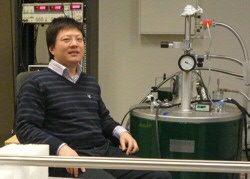Justin Ye scores Science publication with his discovery of Ising superconductivity in a MoS2 field effect transistor

A Ising type superconducting phase with strong alternative paring of electron spins was identified in a field effect transistor (FET) made by a transition metal compound: MoS2. During the experiment in In High Field Magnetic Lab in Nijmegen, Prof. Justin Ye together with Dr. Jianming Lu, and master student Oleksandr Zheliuk found this ultra robust superconducting state under 38 Tesla, the apex of the static magnetic field in Europe. This success largely relies on a new device technology called ionic gating, which enables electric field strength 100 times stronger than that in conventional FET. Hence, a new superconducting state with paring protected by an internal magnetic filed of 100 Tesla can be induced by strong gating.
Discovery of Ising superconductivity not only initiates the deeper exploration into this exotic state of matter but also serves as the pivot that might enable new technologies like ultra robust superconducting electronics.
Evidence of Two Dimensional Ising Superconductivity in Gated MoS2
J. M. Lu, O. Zheliuk, I. Leermakers, Noah F. Q. Yuan, U. Zeitler, K. T. Law and J. T. Ye
| Last modified: | 29 May 2019 12.49 p.m. |
More news
-
24 March 2025
UG 28th in World's Most International Universities 2025 rankings
The University of Groningen has been ranked 28th in the World's Most International Universities 2025 by Times Higher Education. With this, the UG leaves behind institutions such as MIT and Harvard. The 28th place marks an increase of five places: in...
-
05 March 2025
Women in Science
The UG celebrates International Women’s Day with a special photo series: Women in Science.
-
16 December 2024
Jouke de Vries: ‘The University will have to be flexible’
2024 was a festive year for the University of Groningen. In this podcast, Jouke de Vries, the chair of the Executive Board, looks back.
